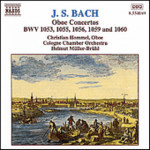
Oboe Concertos, BWV 1053, 1055, 1056, 1059, 1060
 $25.00
Out of Stock
$25.00
Out of Stock6+ weeks add to cart
J.S. BACH
Oboe Concertos, BWV 1053, 1055, 1056, 1059, 1060
Christian Hommel (oboe) / Cologne Chamber Orchestra / Helmut Muller-Bruhl
[ Naxos / CD ]
Release Date: Sunday 19 February 2006
This item is currently out of stock. It may take 6 or more weeks to obtain from when you place your order as this is a specialist product.
When Johann Sebastian Bach, in May 1723, accepted the appointment made shortly before, with an official contract, signed and sealed, to the position of Cantor at the Leipzig Thomasschule, he made a decision that would have far-reaching consequences for the immediate circumstances of his life as well as for the main focus of his creative activity and for the handing down of his work.
Bach himself clearly sensed the implications of this decision, since, in a letter to his old friend Georg Erdmann, he declares that it would be for him "at first quite unsuitable to change from being a Kapellmeister to being a Cantor and so I considered my decision for a quarter of a year."
Since his time at Weimar, from 1708 to 1717, Bach had served first as organist and chamber musician, but then also as concert-master of a court orchestra, an occupation of which involvement with music for instrumental ensemble was a central aspect. This professional orientation was strengthened, after his time at Weimar, by his appointment as Kapellmeister to the court of Cöthen. That this position more than satisfied Bach's expectations is clear from his later and certainly idealised account of that period: "There was a gracious prince, a lover and connoisseur of music, with whom I thought to spend my life."
Bach found the situation in Leipzig brought very different working conditions. Now he had to see to the composition and organization of music in the principal churches of Leipzig, weekly duties that left almost no time for other activities. Only with great effort was he able to free himself from this overwhelming burden by, between 1723 and 1729, composing three complete annual cycles of church cantatas, providing a repertoire on which, in the following years, he could draw without great expense of time. After his cantata period Bach turned his attention again to instrumental music; he composed and published a series of demanding keyboard works and in March 1729 took over the direction of the student Collegium musicum. With this still semi-professional orchestra he was able, at least to some extent, to resume the activity he had carried out at Cöthen; as he had there, he could now, apart from his official duties, perform regular secular celebratory cantatas and, more particularly, purely instrumental compositions.
Nevertheless in his first years at Leipzig Bach must have come to a turning-point that would not have been easy to cross. He was able, now with a distance of years, to publish re-usable works from his time at Cöthen; much here needed modification, adaptation to the new circumstances and conventions. At all events Bach's orchestral works have as a rule only survived in the Leipzig versions, while the artistic output of the period at Weimar and at Cöthen survives not even in outline. Apart from the cycle of Brandenburg Concertos, preserved only through fortunate circumstances, the body of concertos written for the court at Cöthen is now almost completely lost. Nevertheless there are clear indications that Bach, when, in the 1730s, he wrote his series of concertos for one, two or three harpsichords, as director of the Leipzig Collegium musicum, always fell back on early compositions; clearly those concertos for various melody instruments, which he had composed during his service at the court of Prince Leopold of Anhalt-Cöthen, must have served him as originals.
From this has come the understandable desire to reveal the original versions of these works and, as far as possible, reconstruct them for modern performance. Such a project demands an element of courage in dealing with the numerous questions that arise and the few concrete indications. As long as the musical result remains plausible and no dogmatic positions are taken up, this seems a legitimate procedure, to bridge over the gaps in surviving sources – it is, nevertheless, always necessary to bear in mind that we will never know with absolute certainty how the original versions of Bach's harpsichord concertos looked. In this sense the present release must be taken as a contribution to discussion; it is based on the latest researches into the concerto compositions of Bach, according to which it is suggested that these were originally concertos for oboe, an instrument of which Bach, in his vocal music, made full use, so that it is quite conceivable that he also gave it a prominent place in his ensemble music.
Tracks:
Concerto for Oboe d'amore in A major, BWV 1055
Oboe Concerto in G minor, BWV 1056
Oboe Concerto in D minor, BWV 1059
Concerto for Oboe d'amore in D major, BWV 1053
Concerto for oboe and violin in C minor, BWV 1060


